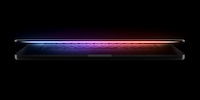
Background information
By how much Apple has reduced Mac prices
by Samuel Buchmann

The new chips in the MacBook Pro make it more powerful and increase the battery life. The M4 Pro in particular appears to be a major improvement on its predecessor. Prices are falling across the board.
Apple already presented the M4 iMac and the M4 Mac Mini. As a finale, the Californians have now unveiled the M4 MacBook Pro. As expected, the laptop may not have a new design, but it does have new chips - and these are a significant upgrade over the M3 generation. The technical data at a glance:
The basic configuration with the regular M4 chip was predictable. As in the Mac Mini, it always comes in the MacBook Pro as a full version with 10-core CPU and 10-core GPU. Just like in the Mac Mini, it is supported by at least 16 gigabytes (GB) of unified memory (RAM). Nevertheless, the devices cost 100 francs or euros less than their M3 predecessors with 8 GB of RAM.
The prices of the standard configurations with M4:
For at least 400 francs or 500 euros more, you can get the faster M4 Pro. It is available either in a slimmed-down version with a 12-core CPU and 16-core GPU - or in the full version with a 14-core CPU and 20-core GPU. Both come with at least 24 GB of RAM. The maximum is 48 GB (and not 64 GB as in the M4 Pro Mac Mini).
At first glance, that's "only" two CPU cores and two GPU cores more than the old M3 Pro. However, Apple is shifting the ratio of efficiency to performance: While the old chip had 6 E-Cores and 6 P-Cores in the full version, the M4 Pro has 4 E-Cores and 10 P-Cores. The effect should be a significant increase in performance. Apple's unspecific graphics suggest an increase of around 30 per cent.

The higher proportion of performance cores does not have a negative impact on battery life. This is because the M4 chips are based on the new N3E manufacturing process, which enables more performance per watt. Apple even claims two hours more battery life than the M3 Pro MacBook Pro. This means that the Pro chip remains the happy medium in the range.
The M4 Pro also costs less than its predecessor, although the RAM level increases by 6 GB. The discount for the cheapest configuration is 150 francs or 100 euros. The standard configurations at a glance:
Apple has made the fewest changes to the architecture of the most powerful chip. The full version of the M4 Max has the same number of cores as its predecessor. Only the slimmed-down version has two more GPU cores. Because the individual cores have a higher clock rate, Apple is still talking about a performance boost of 20 per cent - for both the CPU and the GPU.

One reason for this could be the increased bandwidth of the unified memory. This is up to 546 GB/s with the M4 Max, 37 per cent more than with the M3 Max. Whether the most expensive new chip makes progress in terms of energy efficiency remains unclear for the time being - there is official data for the M4 Max, but none for the M3 Max. What can be deduced from the specifications: With M4 Max, the MacBook Pro lasts three hours less than with M4 Pro.
The price of the Max drops by over 300 francs or 200 euros depending on the model, although the amount of RAM remains the same as with the M3 generation:
Aside from the chips, Apple has improved a few other things, such as the connections: With regular M4, the MacBook Pro now has three USB-C with Thunderbolt 4 (40 Gb/s). In the versions with M4 Pro and M4 Max, the ports support Thunderbolt 5 (120 Gb/s). And the new 12-megapixel webcam with centre stage can now follow you automatically.
The XDR display of the MacBook Pro now reaches up to 1000 nits with SDR content when it recognises a particularly bright environment. In HDR mode, 1600 nits is still possible. For the first time, the display can also be ordered with nano-textured glass. The matt coating reduces reflections, but looks slightly less crisp than a high-gloss display.
In a completely unexpected move, Apple is also doubling the base RAM of the MacBook Air. It now has at least 16 GB of unified memory for the same price. This is equivalent to a price reduction of 220 francs or 230 euros. Apple will no longer sell a Mac with 8 GB of RAM.
The new MacBook Pro will be available from 8 November. You can pre-order the standard configurations here now:
My fingerprint often changes so drastically that my MacBook doesn't recognise it anymore. The reason? If I'm not clinging to a monitor or camera, I'm probably clinging to a rockface by the tips of my fingers.
From the latest iPhone to the return of 80s fashion. The editorial team will help you make sense of it all.
Show all